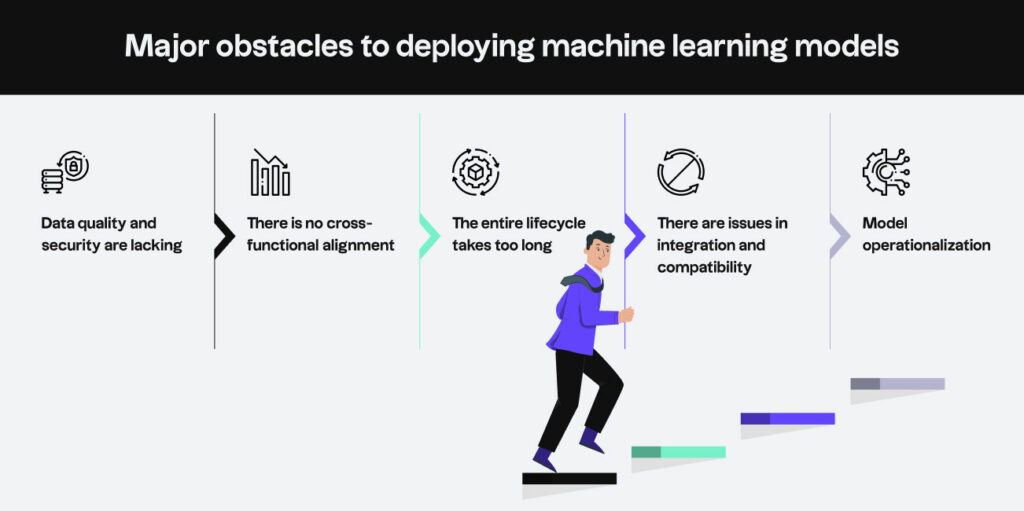
As organizations refocus and restrategize this year, machine learning projects seem to be on the top of IT priority lists. Innovation is more important than ever, and this has led to higher spending, increased hiring budgets, and a wider range of ML use cases.
Despite this, organizations are facing challenges in actually deploying machine learning models at scale. A lot of models are never operationalized, or if they are, the process to production takes too long. In order to fully take advantage of the technology, organizations need to improve the entire ML lifecycle through optimal machine learning operations (MLOps).
A lot of enterprises aren’t there yet when it comes to MLOps
Anyone who has dabbled in advanced analytics can attest to the value fully operationalized machine learning models bring to the table—they can be used to mitigate risks, foresee costly errors, and even save lives. Business decision making is much more improved with actionable foresight, making machine learning a strategic priority across industries.
Early adopters to the ML/AI space, mostly technology leaders, are reaping the benefits, reducing costs, improving customer experiences, and automating processes across the enterprise. In fact, 41% of large enterprises have over 100 models in production.
For the industry as a whole though, it’s a different story. Generally, only about 1 out of 10 models are operationalized. For companies with less than 25,000 employees, only 7% have more than 100 models deployed. What’s more, for 38% of organizations, more than half of data scientists’ time is allotted to deployment—making for an inefficient process and issues in scaling.
It’s clear that the enterprises still have a long way to go when it comes to MLOps maturity. Numerous obstacles plague the lifecycle, and this can hinder any kind of competitive edge that ML/AI normally provides.
4 roadblocks in deploying machine learning models—and what you can do
Below are some challenges that organizations usually face as they delve into machine learning and AI projects.

1. Data quality and security are lacking
The quality of output is only as good as the data being used to train the model. Without data quality management and proper security controls, problems will continue to arise throughout the lifecycle, including information inaccuracy and compliance burdens.
Organizations should prioritize setting up the necessary internal standards and policies to ensure data and model governance early on. When MLOps isn’t embedded into IT policies and organizational processes, the costly regulatory risks may only be apparent when it’s too late—once the model has already been deployed.
2. There is no cross-functional alignment
Oftentimes, the obstacle is as simple as a lack of communication. There is a disconnect between the numerous teams involved—research, IT, engineering, and even executives. When the organization doesn’t agree on the goal of the ML model, what it actually does, and what the model parameters signify, deployment can be pushed back.
To avoid this, establish clear handoff between stakeholders, embed models in decision environments, and get buy-in from top management. Improving model explainability can also help in this regard. Make sure that each parameter of the model is explainable—or that its significance to the final model output is clear—to improve model performance and accountability.
3. The entire lifecycle takes too long
The time required to operationalize models is increasing, with 64% of organizations taking a month or longer. This can be due to a lack of confidence in model performance, framework support and infrastructure, or even knowledge. Scaling up would then be a challenge, and organizations can face issues in versioning and reproducibility.
To improve productivity, consider setting up a continuous delivery pipeline. This often involves an additional set of steps that makes sure the model is ready for production. Setting up real-time model health triggers is also useful. These real-time alerts would help solve any issues as they come up, ensuring optimal performance.
4. There are issues in integration and compatibility
When a machine learning model does get deployed, teams can continue to face challenges in integration and compatibility with the production environment. At times, the model may be outdated, performing poorly, or obsolete.
To ensure operationalization success, prioritize model maintenance and functional monitoring by adoption a retrain-in-production methodology. For example, let’s say we trained a model with data from 2019. Once the model is deployed, we retrain the model again with new data from 2020. This should go on until the desired model performance is achieved.
Making the most of machine learning
Whether large or small, machine learning projects can be a mammoth undertaking, with numerous operational considerations even before one can get started. However, the impact of ML on enterprise decision making and customer experience are too significant to ignore, with insights that often translate to tangible ROI. It would be remiss to write off ML/AI initiatives as the space is gaining more traction, but make sure to invest in MLOps first. The results are sure to be worth it.





